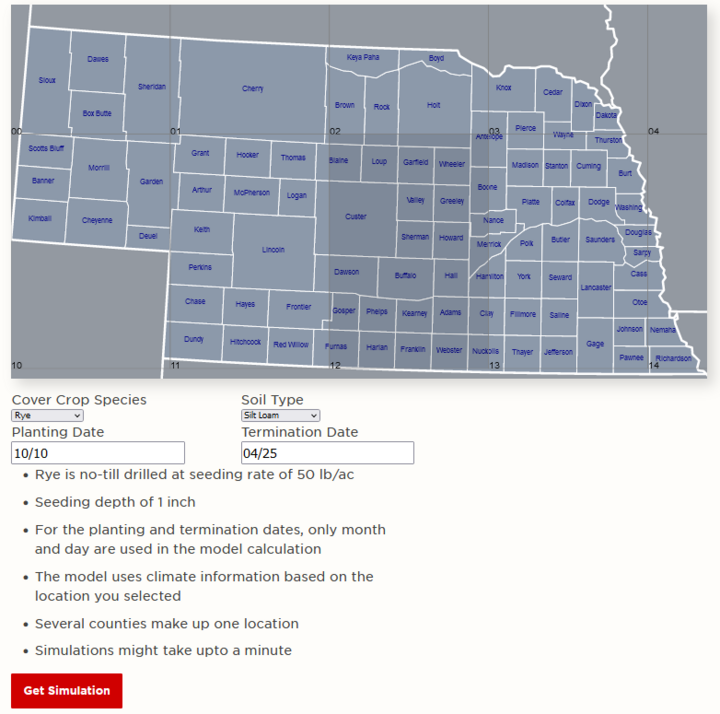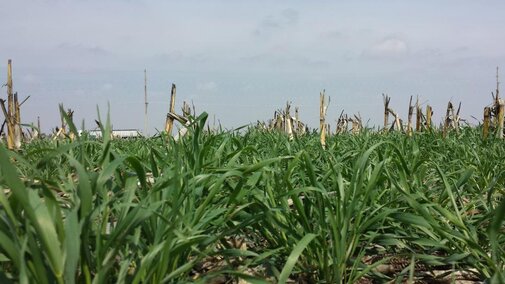Maximizing cover crop growth between fall harvest and spring planting remains a challenge for corn and soybean producers in Nebraska. In a 2017 survey, producers in the state reported their largest challenge to be planting and establishment of cover crops before winter. Nationally, many report that this winter window of time is too limited to achieve enough cover crop growth to justify the associated costs and labor. Additionally, given the wide range of weather conditions experienced in the state during the fall, winter and spring, we cannot expect to see the same cover crop growth from year to year.
A new predictive tool developed by our team estimates cover crop growth with different planting and termination times across the state of Nebraska. The predictions are based on a model called the Agricultural Production Systems Simulator (APSIM), that was carefully set up to represent the growth of cereal rye at different planting timings in Nebraska soils and climates (this work was published in Agronomy Journal in 2020).

The goal of the biomass calculator is to provide producers, researchers and other agriculture professionals with realistic, data-driven predictions to address the challenges presented in the winter growing period. The tool can help answer questions such as “how would biomass vary if I planted earlier or terminated later?” or “how much will cover crop growth change from year to year depending on weather conditions?” This can help you decide what planting windows might be best suited for your environment and adjust management to achieve cover crop biomass goals.
How the Calculator Works
The biomass calculator can be found within the cover crops pages on CropWatch. To use the calculator, first select your location on the map. Next, select the cover crop to be grown from the dropdown menu. Currently, the calculator is only set up to estimate growth of a cereal rye cover crop — one of the most common cover crop species in the state and across the U.S. Lastly, choose the predominant soil texture in the field and proposed cover crop planting and termination dates.
After you have selected these options, the calculator will predict cereal rye biomass, as well as its estimated water use (transpiration) and nitrogen uptake. This information can help create a more complete picture of the cover crop’s impact and benefits.
The “compare” feature allows user to see side-by-side how much growth might occur with different planting and termination dates. Embedded within the predictions you will see a range of outcomes, based on 30 years of weather data for each location. You may notice that the range of predictions is large. This quantifies in a realistic manner how some years may be more or less suitable for cover crop growth. It’s important to highlight that not all years will produce high biomass — in fact, some may be quite low.
Users that would like to see the breadth of possible outcomes for biomass production can click on the reports page found in the Navigation tab. Here, all previously estimated biomass calculations are shown, allowing the user to visualize minimum and maximum biomass production for a range of selections.
Within the calculator platform, you can also find a frequently asked questions page. These questions and answers were developed through ongoing discussions and ideas from an expert farmer-rancher panel, a group of six individuals with extensive experience with cover crops across the state of Nebraska. Overall, we view the biomass calculator platform as an “on-ramp” for those interested in getting started with cover crops and understanding how much biomass a cover crop might produce in a particular region and given different planting and termination windows.
Future Development of the Calculator
Through funding from the Nebraska Environmental Trust, our team worked to develop the biomass calculator platform over the course of a multi-year project. With a new project supported by the NRCS, we plan to expand the calculator to include predictions for more cover crop species. We welcome your feedback to help us improve the calculator. To submit questions and comments, please use the link on the about the project page.
Acknowledgements
This project was a collaboration of researchers from UNL’s Department of Agronomy and Horticulture, Nebraska farmers, and UNL’s Holland Computing Center.
This project was made possible with the generous funding from the Nebraska Environmental Trust, project number 19-138-3. https://environmentaltrust.nebraska.gov/

